If you’re a drummer who plays live shows, a good set of cases is crucial. Cases won’t only keep your drums looking great on stage, but also maintain their monetary value. Cases can also make carrying your gear a lot easier, cutting down your setup and teardown times.
Of course, there are many options when it comes to drum cases. You can go with lightweight soft bags, hard-shelled cases, or something in between. Hard-shelled cases are ultra-protective, but they’re hard to transport and they’re the most expensive option available. Lightweight bags are easy to transport and less expensive. However, lightweight bags aren’t very protective and they tend to wear out quickly.
That leads us to the option we like best – Ahead Armor cases. They offer a solid mix of protection, transportability, and value. For most gigging drummers who can afford them, we think these cases are a fantastic choice.
We took a set of Armor cases out for a few dozen gigs to get a good feel for their quality. We’ve seen how they protect, how they perform, and how they hold up over time to normal wear and tear. Overall, the results have been great. Now, we’ll tell you why we like these cases, while also getting into a couple of things we don’t like. In the end, hopefully you’ll have the information you’ll need to know if these cases are right for you.
Here’s our in-depth look at Ahead Armor drum cases.
*This post includes affiliate product links. We may receive a small commission from purchases made through those links, but your price does not increase at all. We take pride in only recommending the products that will help drummers most. Thank you for the support!
Overall Build
One of the most impressive things about Armor drum cases is their build quality. Cheaper drum bags have a few common weak links. Zippers fail, corners erode, and stitching comes apart. The Ahead Armor bags put a focus on those vulnerable points, making the overall product much more durable. Even though they’re soft cases, the robust materials and overall designs are built to last.
Zippers
Zippers can be a frustrating weak point on cheap drum bags. They tend to get jammed or come apart unexpectedly. Even if you can get a zipper back together, it’ll probably just come apart again. Zipper pull tabs are also often poorly made on lightweight bags. Brittle construction can cause them to snap, even from normal use.
Armor case zippers are made very well. In our time using these cases, we didn’t have a zipper get stuck or break in any way. If you inspect one of the zippers, it’s easy to see why. Take a look at the construction:
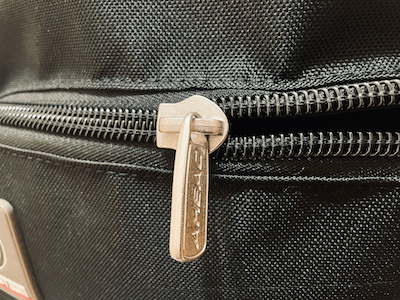
The pull design is thick and strong. Not only does that make the tab almost impossible to break, but it helps the zipper open and close smoothly. Overall, this zipper design is the best we’ve seen on any drum case we’ve tried.
Corners
When these Armor cases were designed, they were reinforced where cases take the most abuse. The edges of a case almost always get the brunt of the wear and tear. Over time, holes can form, which tend to grow. Here’s what a common lightweight case corner looks like:

There’s little or no reinforcement there. However, take a look at the edge of an Ahead Armor case:
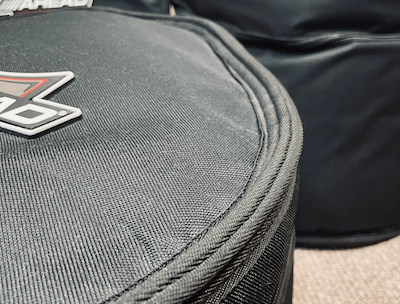
It would take a lot to wear through one of those reinforced corners. That extra material also helps protect your drum. When you put a heavy drum down on a hard surface, the corner is what typically makes impact. With the extra cushion, your drum hoops get a softer landing.
Handles
Cheap straps and handles can be a very costly problem. We’ve seen case straps rip off due to insufficient stitching. It’s most likely to happen with bass drum cases that carry a heavy load. Of course, the bass drum will crash to the ground if a strap breaks. Add in the thin padding that most of those bags have and you may have a cracked hoop or drum shell.
The Armor case handles are more secure. The stitching is plentiful and strong. There’s more surface area attached to the case’s exterior. Plus, with a quality 600D polyester surface material, the stitching is attached to a firm base.

Ultimately, it would take something beyond normal use to tear one of these handles off.
No Shoulder Straps
That leads us to a minor complaint about Armor cases. While shoulder straps are incorporated into the designs of some of the cymbal and accessory bags, they’re not part of the drum bags. The included handles are nice, but they’re short. We would really like to see shoulder straps included on drum bags, especially on large sizes.
That being said, you can augment your case with a strap. Ahead offers a strap that you can clip around the case handles, but the strap is quite long. We added a shorter aftermarket strap to the bass drum case and the results worked well. It wasn’t a perfect solution, but it certainly made transporting that drum easier.
What we used was a 1.5″-wide nylon shoulder strap, adjustable from 24″-36″, with large carabiner ends. We clipped those ends onto two of the case handle straps, then secured the velcro handle with a velcro cable tie. Here’s what that setup looks like:

No matter what strap you use, you may want to secure the padded handle with a velcro tie. That will keep the case handle from peeling apart. Again, it would be better to have a shoulder strap built into the bag design, but this DYI solution helped us.
Padding
The interior is what often first attracts people to Armor cases. All of the drum cases have a Sherpa fleece interior, surrounding your drum with a soft layer of protection. The material is well-made and durable. In our time with these cases, we saw very minimal fleece shedding.
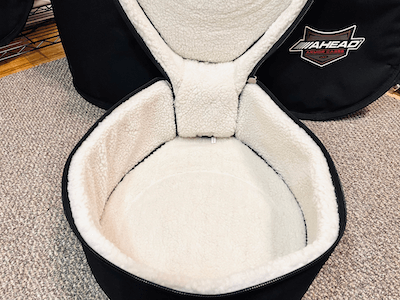
Beyond the interior fleece, these bags have 3 layers of protective foam. When we accidentally bumped a drum into a doorway or table, those mishaps didn’t lead to any damage whatsoever.
Case Types
Armor cases come in many types, including for bass drums, toms, snares, cymbals, hardware, pedals, and hand drums. During our evaluation period, we used the bass drum, tom, snare, and hardware cases. Those are the versions we’ll write about in some detail below. We plan on writing more about some of the other offerings in the future, as well.
Bass Drum
Ahead Armor bass drum cases come in over 30 sizes at the time of writing. That covers just about every diameter and depth you may have. These bass drum cases are made with all of the high-quality specs we discussed above. They also include Ahead’s DynaZip zipper design and Shark Gil handles.
The DynaZip zipper design travels around the diameter of the case, then down vertically. This allows you to open the case very wide.

We found that it was usually unnecessary, but for a good reason. Because the case has a firmness built into the padding, the edges tend to stand mostly upright. It’s usually very easy to put the case on the ground, then just place the bass drum in.
The Shark Gil handles are very useful when it comes to bass drum cases. These side handle slots allow you to comfortably grip the sides of the case. It’s an ergonomic way to move a heavy drum around with two hands.
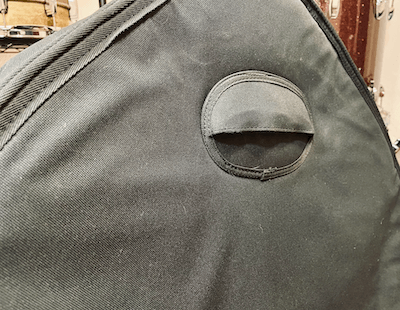
Finally, the bass drum case uses Ahead’s TruForm shape design, which allows you to tuck mounting hardware or a leg into the case’s teardrop contour. It’s another small design feature that makes Armor cases easier to use.
Toms
Armor tom bags come in 27 different sizes at the time of writing. Like the bass drum cases, these tom bags include the DynaZip zipper design, traveling both around the case diameter, as well as vertically. The handle design depends on the size of the tom. Floor toms have a 2-piece handle design, like the Armor bass drum cases. Smaller tom sizes have a simpler single-piece design.
The TruForm teardrop shape is especially useful when it comes to toms. The design allows you to tuck a mounting bracket into the elongated section.
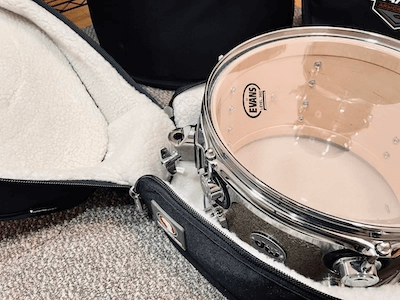
You don’t have to worry about adding extra size for a suspension mount. Just match the case size with the diameter of your drum. Positioning the suspension mount bracket into the teardrop will ensure a comfortable fit.
Snare
Ahead Armor snare cases currently come in 11 different sizes. They’re a lot like the small tom bags, with a single-piece handle. However, the snare case zippers have a simpler shape, only traveling around the diameter of the drum.
The snare case design is another example of the usefulness of the TruForm shape. Other brands compensate for snare strainers by enlarging the case diameter. With a teardrop design, the strainer fits snuggly, while providing a tighter fit around the rest of the drum.
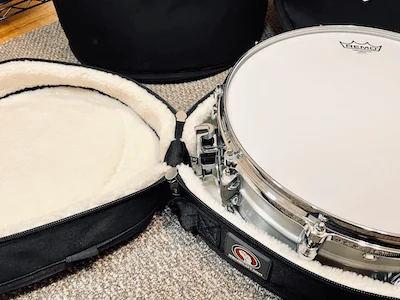
With this design, your snare won’t move around so much as you carry the case around. Transporting in tight-fitting cars is also a bit easier.
Hardware Case
As much as we like the drum cases, the Armor OGIO hardware version may have been our favorite. The design is just about perfect in our opinion. It’s rugged, has a very useful pull handle, big wheels, and ergonomic straps. We dragged it over curbs and up steps. We rolled it over pavement, grass, and dirt. Through it all, the case still works like new.
These hardware cases come in 3 sizes. They all have the same width and depth, but vary in length from 28”-48”. The 2 longer depths have a slightly different bottom, incorporating a skid plate. We used the 28” length, which doesn’t have a skid plate, but still has protective rails.
Part of the reason we chose the shortest length was just to see how much we could fit into it. We were very surprised by the result. The majority of our gigs were played with 3 flat-based boom stands, a medium-weight snare stand, a 2-legged hi-hat stand, a tom holder, and a Pearl Roadster throne. It all fit into the 28” Armor hardware case. We were also able to fit a single bass drum pedal in, as well, but usually kept that in a separate case just to be safe.
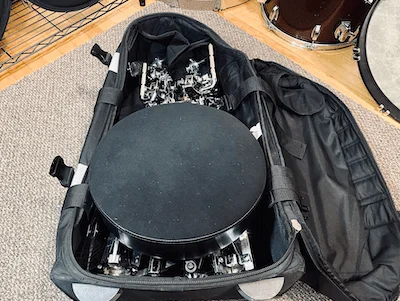
In order to fit all of this inside, the hardware had to be placed in somewhat of an order. Once we learned that, it was very easy to pack up. These bags also have a separate pocket inside the flap, where we put floor tom legs, the top of the hi-hat stand, and a stick bag.
After everything is stacked in place, there are 2 security straps inside to ensure your gear is locked in place. Then, our favorite part – this bag will sit upright, even when it’s packed full of gear. That’s a big space-saver!
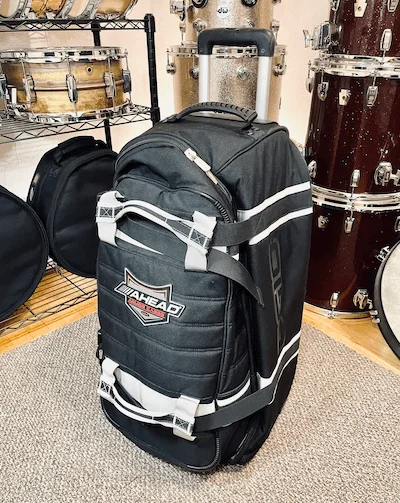
If you have standard double-braced hardware, you’d probably be better off with the medium or large sized bag. They’re all very durable and make transporting hardware as easy as it can be.
Wrap-Up
That’s our in-depth look at Ahead Armor drum cases. All told, they’re our favorite case option for most gigging drummers. They’re not cheap, but you get a lot for your money. You’ll get a great mix of protection, transportability, and durability. In our time with them, our opinion of them only became more positive. If you can afford these cases, we’re confident you’ll be happy with the investment for many years to come.
By Peter Treuden – About the Author
If you’re a gigging drummer, check out our Easy Essential Emergency Drum Supplies!

